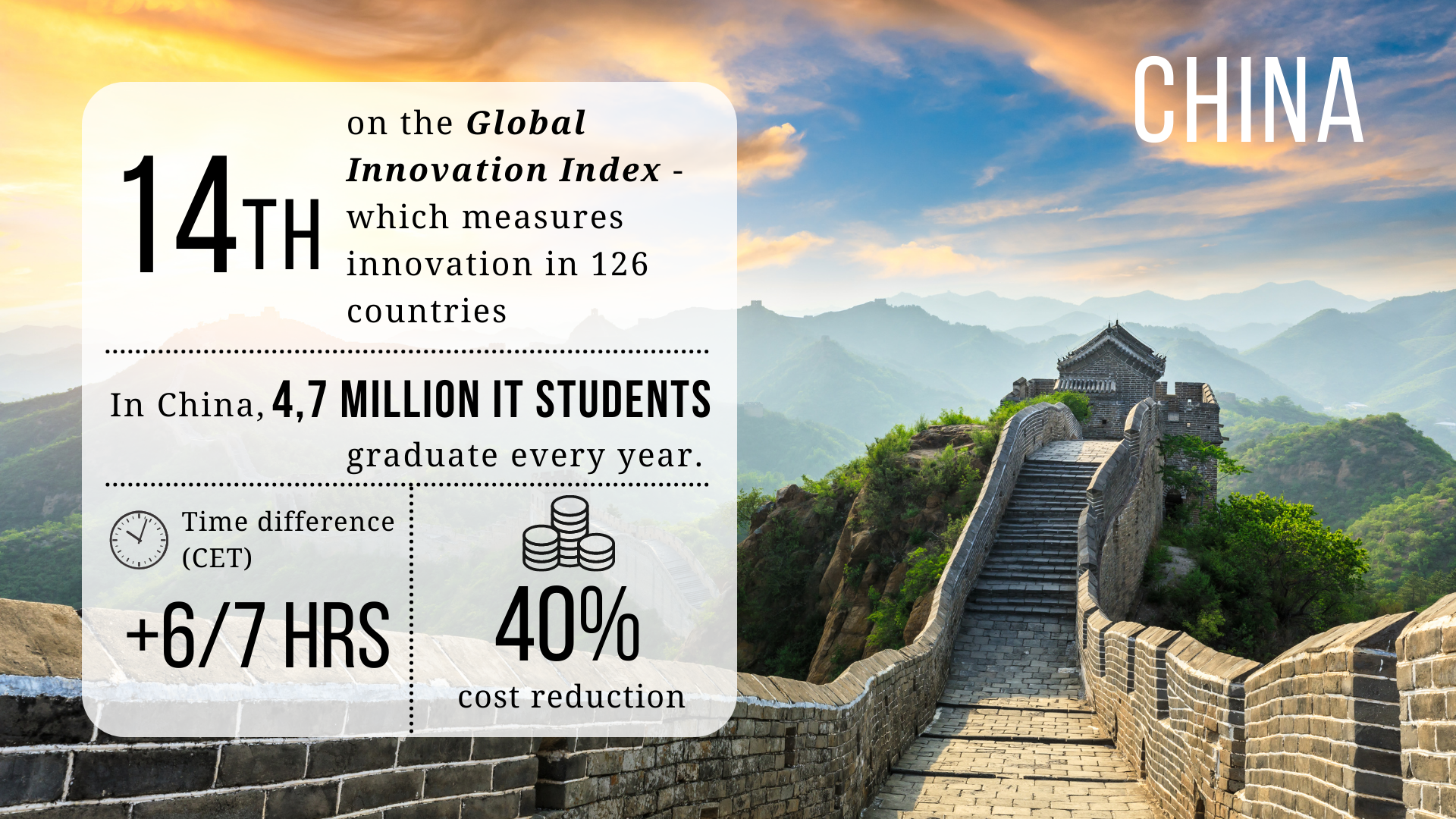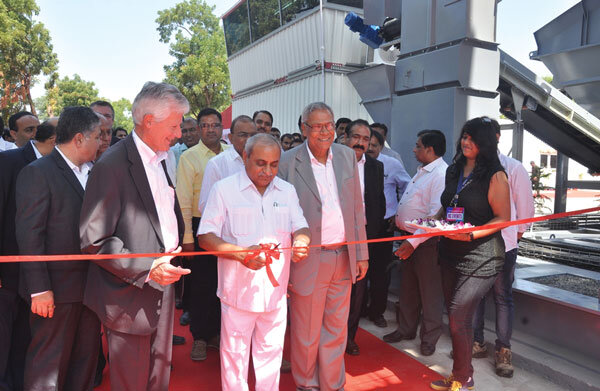It is currently difficult for European companies to find good IT professionals, engineers, data specialists and other technical staff. For years, companies have been looking across borders for solutions in the form of a remote team or outsourcing. But what is the best destination for setting up such a remote team? Where can you find a large pool of highly educated people who speak English well? We take a closer look at four popular destinations: India, China, Argentina and Poland.
India has more tech talent than Silicon Valley
The Indian talent pool
According to a study by Price Waterhouse Coopers, India is not only the largest IT hub in the world, but cities such as Bangalore and Pune attract more tech talent than Sillicon Valley. India has one of the largest and most educated talent pools in the world. Around one and a half million students enter the country's technical universities every year, and they are not the least of these. In fact, six of the seven Indian universities with a QS World University Ranking are technical universities. According to research by Gild , Indian developers scored as much as 11% better than their American counterparts on maths and mathematics assessments. Indians also speak excellent English, the country's second official language.
The Indian IT market
India is the country with the most ISO-9000 certified software companies in the world. ISO stands for International Standard Organisation and the certificate guarantees the quality of software design, development, production and installation. In addition, over 75 per cent of the global CMMI Level 5 certified IT companies are located in India. The CMMI is a scale that indicates the level of software development of an organisation. The model distinguishes five levels, of which 1 is poorly developed and at 5 the development process runs like a well-oiled machine. With about 67% of the global market, India is the world's largest outsourcing destination for the IT industry. India's outsourcing market currently employs around 5 million developers who specialise in app development, both native and hybrid, the Python, Java, JavaScript, C/C++ and PHP programming languages and the country is rapidly developing machine learning, AI, GIS and blockchain technologies.
The advantage of outsourcing to India
By outsourcing your IT or R&D to India, you can not only make significant cost savings of 50-80%, but you can also use the 4.5 hour time difference (3.5 in summer) to your advantage. For example, by solving problems before your European employees or users are affected. For this reason, ARS Traffic & Transport Technology in The Hague, a leading player in technological traffic solutions, has had an R&D facility in India for the past twenty years. In addition to software development, the section control systems and matrix signs along Dutch motorways are monitored from the Indian ARS T&TT office. "If a system breaks down, due to the time difference, we can repair the system before the rush hour starts," CEO Jan Linssen told us.
China invests to become a major tech destination
The Chinese talent pool
The Chinese government has been investing in improving the country's tech sector for several years now and it seems to be paying off. China is not only the birthplace of big tech companies such as Huawei, Alibaba and ByteDance, the parent company of the app TikTok, but is now also ranked 14th in the Global Innovation Index. This is an annual ranking that ranks 126 countries based on their ability to innovate. Science and maths are also major focus areas in Chinese schools and universities, resulting in some 5 million IT students graduating each year. Because technology is a relatively new focus of the Chinese government, the IT sector is still very young. About 57 percent of the Chinese developers have only one to three years of working experience. This makes them a lot less experienced than their international colleagues, where half of them have four to ten years of experience.
The Chinese IT market
According to experts, the Chinese IT sector is highly fragmented. There are few large IT companies and the small companies all focus on the domestic market. This is partly because Chinese developers often speak little or no English. China is now mainly concerned with product development and low-end, relatively uncomplicated IT applications. Although the IT products developed in China are simpler, the price is not extremely low anymore. On average, a cost reduction of 40% can be expected. One of the biggest obstacles for foreign companies wishing to outsource to China is the lack of intellectual property protection. Although the government is already working hard to crack down on piracy and other forms of intellectual property infringement. Chinese developers generally excel at functional programming and the Python and Shell script programming languages.
Argentina is the number one outsourcing location for US companies
The Argentine talent pool
Over the past 20 years, Argentina has invested heavily in technical higher education, with some 90,000 students now leaving university each year with a technical diploma. In recent years, several Argentine universities have appeared in prestigious international rankings, including QS, the Center for World University Rankings (CWUR) and Times World University Ranking. As a result, Argentina's talent pool has grown to around 135,000 developers in a short period of time. According to the 2019 Global Skills Index by Coursera , Argentine developers are the best software engineers in the world. They also speak the best English in all of Latin America. The cost savings that outsourcing to Argentina could bring you depends on the erratic economy. At the moment, the country is relatively cheap and would be around 40 percent, but in good times it would be more like 20.
The Argentine IT market
Despite Argentina's faltering economy, the country's IT sector has been showing strong growth of around 3 to 5 per cent per year for a decade. This is partly because the Argentine government made the growth of this sector a priority back in 2004 by introducing the Ley de promoción de la industria del software. This law made the sector completely free of restrictions on foreign investment, making software development the most important source of foreign investment, up to 58 per cent, in Argentina. Argentina's IT sector comprises about 3,800 companies, including big names such as IBM, Intel, Motorola, Microsoft, Oracle, Siemens, and Gameloft. It is the number one outsourcing destination for companies from the United States due to the zero time difference. The difference with Europe is quite significant, with the Netherlands running four hours ahead. Outsourcing companies in Argentina specialise in app development, open source projects, cloud computing, Magento, PhP and DevOps. 60 percent of the IT companies are ISO9001 certified.
Poland is the Finech location of the European Union
The Polish talent pool
The best universities in Poland are four technical universities, and some 140 000 technical students graduate there every year. IT courses in the country are very popular not only among Polish but also among international students due to their high level and low cost. The IT industry in Poland has about 300,000 developers, but 80 per cent of them work in the R&D offices of tech giants such as Motorola, IBM and Shell. Poland is in fact known as the R&D hub of Europe. Only 20 percent of Polish developers are therefore available for outsourcing projects. Poland has no time difference and no major cultural differences with most Western European countries, so the prices are at a European level. The cost savings from outsourcing IT or R&D will be around 20-30 percent.
The Polish IT market
The Polish IT market is growing at a steady pace. In 2019, the sector grew by about 2.9 per cent and revenues increased by 4.6 per cent. This makes the IT industry account for about 8 percent of Poland's GDP. In addition to the many large multinationals that have established their R&D in Poland, the country is also known as a good location for FinTech projects. Developing such projects requires experience to make them bug-free and, more importantly, safe for users. Polish developers are experts in this field. Poland is the largest FinTech market in the European Union with an estimated value of €856 million. Because Poland is a member of the EU, it follows European privacy and intellectual property laws. This can give European companies a huge advantage when they want to start a web development project. Front-end and back-end development is therefore a much sought-after service by European companies. Polish developers are also known for their specialisation in PHP, Java and .NET.
This is the time to outsource
All four locations have their advantages and disadvantages, but one thing is clear. Since the outbreak of the pandemic, we have faced a major challenge worldwide. Companies have suffered a severe financial blow, but at the same time the need for digital solutions for customers and employees has increased. Cutting your IT budget is impossible in today's digital world, which is why outsourcing internal IT is a solution that can save a lot of money. Wondering how outsourcing to India will benefit your business?






